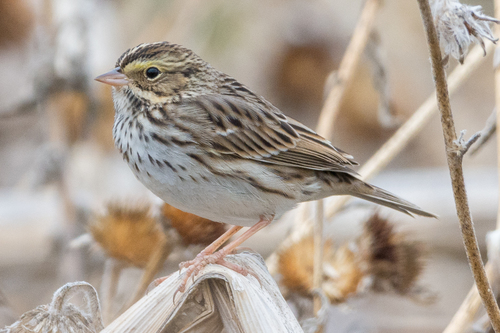
Savannah Sparrow
The Savannah Sparrow (Passerculus sandwichensis) is a small, widespread songbird found across North America. While often overlooked due to its streaky brown plumage, it plays a vital role in grassland and agricultural ecosystems as both a seed disperser and consumer of insects. It is known for its subtle beauty, with variations in plumage and song across its many subspecies. The species derives its common name from Savannah, Georgia, where one of the first specimens was collected. It holds no significant cultural importance other than being a common subject of study for ornithologists and birdwatchers.
11-15 cm
Length
18-25 cm
Wingspan
Least Concern
Conservation Status
Distribution
Breeds across North America, from Alaska and Canada south to Mexico and parts of Central America. Winters in the southern United States, Mexico, and the Caribbean. Some populations are resident year-round, while others are highly migratory, traveling thousands of kilometers.
Lifespan
Up to 9 years in the wild, but typically 3-4 years.
Savannah Sparrow's Habitat
Habitat Types
Grasslands, Prairies, Meadows, Agricultural fields, Salt marshes, Tundra
Climate Zones
Temperate, Subarctic, Tropical (in wintering areas)
Adaptations
Their ground-foraging behavior and cryptic coloration provide camouflage in open habitats. Strong legs and feet are adapted for running and scratching in search of food.
Variations
Numerous subspecies exist, exhibiting variations in plumage color and size. For example, the 'Belding's' Savannah Sparrow is darker and found in coastal salt marshes, while the 'Ipswich' Sparrow is paler and found on dunes.
Appearance
Breeding Plumage
Plumage is generally similar year-round, but breeding birds may have slightly brighter colors.
Seasonal Feather Changes
Limited seasonal variation; some individuals may appear slightly duller in winter.
Sex Based Plumage Differences
Males and females are visually similar.
Notable Features
Streaked brown back and flanks, White underparts with brown streaks, Yellowish eyebrow stripe (varies in intensity), Short, notched tail
Diet and Feeding
Primary Foods
Seeds, Insects, Small invertebrates
Foraging Behavior
Primarily forages on the ground, walking or running while searching for food. Often scratches at the soil surface to uncover seeds and insects.
Specializations
No highly specialized feeding adaptations, but their bill is well-suited for handling both seeds and insects.
Seasonal Diet Variations
Diet shifts seasonally. Insects are more prevalent in the diet during the breeding season when protein demands are higher for chick-rearing. Seeds are a more important component in winter.
Behavior
Social Structure
Generally solitary or in pairs during the breeding season. Forms small flocks during migration and winter.
Communication
Simple, high-pitched song (often described as a series of chips and trills), Various call notes, including a 'tsip' or 'seet'
Migration
Many populations are migratory, traveling south for the winter. Migration is often nocturnal.
Territorial or Group Behaviors
Males defend breeding territories through song and aggressive displays. During the non-breeding season, they are less territorial.
Conservation
Threats
Habitat loss (due to agriculture and urbanization), Pesticide use (reducing insect prey), Climate change (altering habitat suitability)
Protection Programs
Conservation Reserve Program (CRP) in the US (provides habitat on agricultural lands), Monitoring programs (e.g., Breeding Bird Survey)
Local National Laws
Protected under the Migratory Bird Treaty Act in the US and Canada.
Population Trend
Slight Decline
Population Estimates
Estimated global population of 170,000,000.
Interesting Facts
They are incredibly diverse.
There are over 20 recognized subspecies of Savannah Sparrow, each adapted to slightly different environments.
They can be surprisingly hard to spot.
Despite their abundance, their cryptic coloration and ground-dwelling habits make them easy to overlook.
Some are long distance travellers
Some populations migrate thousands of kilometers between breeding and wintering grounds.
Faqs about Savannah Sparrow
What is the best way to attract Savannah Sparrows to my yard?
Provide open grassy areas with native seed-bearing plants. Avoid using pesticides.
How can I tell a Savannah Sparrow from other sparrows?
Look for the combination of a streaked breast, yellowish eyebrow stripe, and short, notched tail. The song is also distinctive.
Are Savannah Sparrows endangered?
No, they are currently listed as a species of Least Concern by the IUCN, but some subspecies are of conservation concern.
Copyright @ Nature Style Limited. All Rights Reserved.
 English
English